|

 Up
Up 
 Wright Models
Wright Models 
(You
are here.)
 Down
Down




  Need
to Need
to
find your
bearings?
Try
these
navigation aids:
If
this is your first
visit, please stop by:
Something
to share?
Please:



|
|
Available in Française, Español, Português, Deutsch, Россию,
中文,
日本, and others.
 hen
you're giving a report or presentation on the Wright brothers, there
are few things more impressive than having a model of the Wright
Flyer on hand to help illustrate the points you're making. This is
especially true if you've built the model yourself. The
trick is getting the right model kit. There are a lot of Wright
Flyer kits out there, and some are better suited for presentations
than others. hen
you're giving a report or presentation on the Wright brothers, there
are few things more impressive than having a model of the Wright
Flyer on hand to help illustrate the points you're making. This is
especially true if you've built the model yourself. The
trick is getting the right model kit. There are a lot of Wright
Flyer kits out there, and some are better suited for presentations
than others.
|
|
Static Models
|
|
|
EASY BUILT MODELS (Wood) –
If you need a static (non-flying) model, Easy Built Models offers
two detailed balsa-wood-and-tissue-paper kits for a model with
a 24-inch wingspan (about 1:20 scale). These are absolutely the best
kits for demonstrations and presentations for the simple reason that
they are built exactly like the Wright Flyer was built (only
somewhat smaller, of course.) You can point out the ribs, spars,
struts, rudder, elevator, engine, propellers
– all the major parts on the
model match the parts on the real thing. If you want to add even
more detail, you can consult the plans we've included below. An
experienced modeler can, in fact, build this up to be a museum
quality Flyer model with some extra research and effort.
Another feature that recommends this model are the detailed,
illustrated instructions that come with it. There are dozens of color
photographs that show you just what to do, step by step. The kits
also includes full-size templates for the subassemblies (wings,
skids, elevator, and so on). You simply tack the templates to a
board, then glue the subassemblies together right over the
templates. The combination of detailed instructions and full-size
templates makes the construction relatively easy, even for
first-time and inexperienced modelers. The only thing thing we
thought the kits lacked was a good rigging plan. The plan provided
is not just basic, it's inaccurate. And it makes no attempt to
distinguish between rigging and control wires. But it's an easy fix
– download the measured drawings
offered below and use them to rig the model.
Both kits will result in exactly the same model; the difference
is how the wooden parts are delivered.
- The
less expensive kit provides balsa wood with the parts
printed on the wood. You must cut them out yourself, a
time-consuming task.
- The
more expensive kit provides the balsa wood with the parts
already laser-cut, saving you a good deal of tedious work.
However, you must sand the burned marks from the lasered
surfaces, which is also a tedious task.
Builders often submit photos of their completed models (both
laser-cut and printed), and Easy Built shows these on their
web site.
|
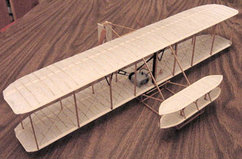
This model was built by Thomas Havens from the kit with printed
parts.
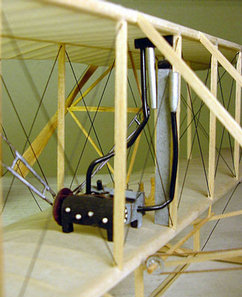
The engine and cockpit area of this laser-cut kit show some
wonderful details that were added by the builder, Andrew Sanchez.
You'll find many more photos from builders on the Easy Built Models
web site.
|
|
GUILLOW'S MODELS (Wood) – Guillow's also offers
a laser-cut balsa wood model similar to the model offered by Easy
Built. It's the same size (24-inch wingspan), the same level of
complexity, and nearly the same price. Guillow's also
provides paper templates for accurate glue-ups. However, the
resulting model is not quite as detailed as the Easy Built
model, and the instructions for building it are not as
comprehensive. It does , however, offer two things that the Easy
Built model does not -- a display stand and a laser-cut
silhouette of Orville flying the airplane.
|
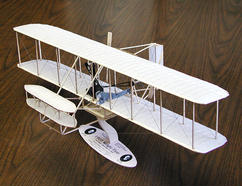
Guillow's Wright Flyer model comes with a stand and a silhouette of
Orville in the cockpit.
|
|
LEGO (Plastic) – While it's no longer being
manufactured, it's worth noting that Lego once offered a
Wright Flyer kit. It wasn't what you could call an accurate model.
With all the bumps and holes in the wings, Wilbur and Orville would
have had a hard time keeping it aloft. But it had the definite shape
of a Wright Flyer. And it offered one amazingly accurate detail that
no other static models have duplicated before or since. The struts
were hinged to the wings in the same way that the Wright
brothers joined their struts and wings. This makes it possible to
warp the wings of the Lego Wright Flyer. Too cool. Our
bowlers are off to the Lego modelers. Although you can no
longer purchase this Lego kit commercially, they do come up
for auction every so often on
Ebay.
|
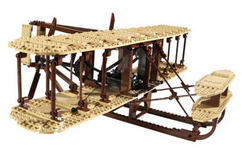
Lego made this Wright Flyer kit available briefly for the Centennial
of Flight in 2003.
|
|
MODEL AIRWAYS (Wood and Metal) – If you're looking to
build a museum-quality 1903 Wright Flyer model,
Model Airways offers the most accurate kit that we have
yet examined. The wooden parts are laser-cut from balsa wood and
most of the metal parts are etched from brass, all in striking
detail. The kit includes assembly jigs and full-size paper templates
for accurate glue-ups, as well as a 28-page illustrated booklet with
step-by-step instructions. The resulting model is 1:16 scale with a
30-inch wingspan and 15 inches from nose to tail. Unlike other
model kits, Model Airways does not provide a wing coverings.
They suggest you leave the model uncovered to show off the
construction details. You might also leave one half of each wing and
control surface uncovered to give the viewer an idea of how the
completed Flyer looked without hiding the details. If you prefer to
cover all or half the surfaces, you can buy coverings such as
tissue, silk, Silkspan and Koverall from most modeling suppliers.
For all their attention to detail, it's surprising that Model
Airways let slip one minor inaccuracy. The ribs on the canard
(front elevator) supplied by Model Airways are cambered (curved). On
the actual Wright Flyer, they were straight. Wilbur and Orville
designed the canard so that when the elevator surfaces were pitched
up, the ribs flexed and developed a positive camber (producing
positive lift). When pitched down, the ribs flexed in the opposite
direction, developing a negative camber (and negative lift).
Fortunately, it's an easy fix -- just discard the cambered ribs and
substitute straight pieces of balsa wood.
|
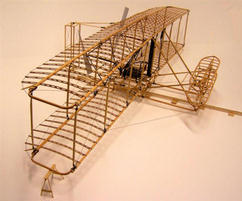
A completed Model Airways Wright Flyer model by Robert Byrnes.
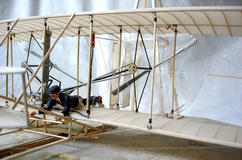
Lee Herron built this Model Airways Flyer for a diorama, but decided
to cover the wings. You can see the details of his amazing display
HERE.
|
|
REVELL (Plastic) – Revell (formally
Revell Monogram) offers a detailed plastic 1/39 scale model Wright Flyer,
with a wingspan of just over 12 inches. It's not as impressive as
the Easy Built or Guillow's models, nor does it's construction mirror the real
Flyer. For example, you cannot point out the ribs and the spars in
the wings -- they are just sheets of molded plastic. But it is
a good deal simpler to build than a balsa-wood-and-tissue-paper
models, and it's less expensive. It also offers a launch track,
figures of Orville and Wilbur, and some of the tools that were laying
around in the sand that you can see in the famous photograph taken
of the first flight.
You cannot buy these models directly from Revell, but you can
find them at many hobby suppliers on the Internet. We suggest you
try
Scale Hobbyist first, since they carry a large inventory of
historic models. If they are out-of-stock, google "Revell Flyer
Model." or search
Ebay.
Note: As of this writing (December 2014), the Revell models
of the Wright Flyer are in stock at Scale Hobbyist. To get to the
order page, click
HERE.
|
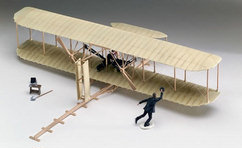
The Revell plastic Flyer model, assembled and painted.
|
Flying Models
|
|
|
RC and Rubber-Band – By far, the best and most detailed flying
models of the Wright Flyer are offered by Brodak of
Carmichaels, PA. Brodak sells two laser-cut model kits for the 1903 Wright Flyer,
each with a different power source.
These flying models were developed by Pat Tritle, a veteran
model-designer with talent and tenacity the would make Will and Orv
envious. Pat has graciously contributed a page to our web site that
describes how he developed the RC Flyer. To read Pat's piece, click
HERE.
If you would like to see one of Pat Tritle's RC Wright Flyer in flight, click
HERE. And if you'd like to visit his personal web site, you
can find it
HERE.
|
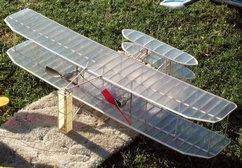
Pat Tritle's radio-controlled model of the 1903 Wright Flyer.
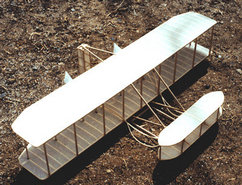
The rubber band-powered version.
|
|
Rubber-Band – This rubber band-powered Flyer model is
made by Lyonaeec, a manufacturer of almost-ready-to-fly
airplanes. It was designed by Dr. Danny H. Y. Li, who flew it at the
Wright Brothers National Memorial in Kitty Hawk, NC, for 350 feet
(106.6 meters) -- almost three times the length of the first flight
on 17 December 1903! The model is made from plastic and structural
foam parts that snap together to make an airplane with a 19-inch
(490 mm) wingspan. A single rubber band turns a gear-drive "engine,"
which in turn spins two contra-rotating props. To launch the model,
you simply wind up the rubber band with a handy ratchet winder, then
press a lever at the back of the model to release the torsion and
start the propellers. While it doesn't look as historically accurate
as other models you can buy, it's ingenious, easy to build, and
flies surprisingly well. You can see a video of Dr. Li flying his
"WF-1" model at the Wright Memorial
HERE.
|
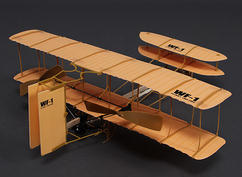
A rear view of the WF-1 rubber band-powered Wright Flyer.
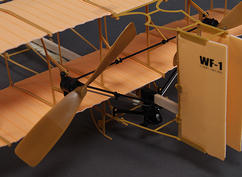
A close up of the WF-1's propellers and "engine."
|
Toothpicks and Paper – That's right, toothpicks! Rob Elliott, proprietor of Booger Red's Books,
is the inventor and designer of a "Toothpick Air Force." Bob
makes tiny, delightful flying models, no bigger than your
finger, from paper and toothpicks. Several years ago, Rob sent us a 1902 Wright
Glider, a 1905 Wright Flyer 3, and a 1911 Wright Model B in a greeting
card box. He doesn't sell kits, but he does make plans available. The
plans for the Wright models I just mentioned are in a book called The
First Flyers, available from Rob's company. In fact, there are 22
pioneer airplane models here, including the June Bug, a Voison, a
Bleriot 12, a Curtiss Model D, a Deperdussin, and
just about ever other important aircraft from the years between 1902 and
1914. You can purchase The
First Flyers from:
Booger Red's Books, Inc.
P.O. Drawer G
Clifton, CO 81520
(970) 434-4140
Email: booger@gi.net
Rob has also recreated toothpick versions of two of the Wrights'
experimental airplanes, the 1902 glider and the 1903 Flyer. You can demonstrate the
invention of the airplane – or the entire history of pioneer
aviation – using his models. Rob thoughtfully collected
the plans for his experimental Wright aircraft, plus instructions
and tip for building and flying the models, for the Centennial of
Flight in 2003. You can get a copy in PDF format right
HERE.
By the way, "Booger Red" was a slang term for "undertaker" in the
American West where Rob lives.
|
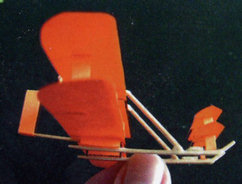
The Toothpick Airforce's 1903 Wright Flyer.
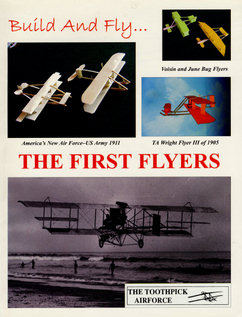
Rob has also written The Toothpick
Air Force, which contain plans for both historic and modern
tiny aircraft replicas..
|
Scratch-Built
|
|
|
NASA – One of the best plans we've seen for a simple,
scratch-built 1903 Wright Flyer model was developed by Roger Storm
at the NASA Glenn Research Center. Roger used foam meat trays for
the wings and control surfaces, toothpicks for most of the wooden
parts, and the little bit of balsa wood for the longer wooden parts.
You can also substitute bamboo skewers for these long parts, making
it possible to pick up everything you need to build this Flyer at a
grocery store! Despite the humble materials, however, this is a
remarkably accurate model. And you can make it even more accurate by
using the plans we've included in this section to add rigging and
other details.
|
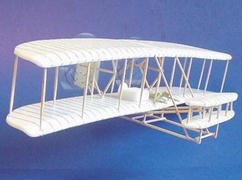
In addition to building the Flyer, Roger also shows you how to make
Orville and Wilbur figurines from plastic soldiers.
|
|
Plans – If you want to design and build your own model from
scratch, you'll need a set of measured drawings. You may also need
these drawings if you want to add detail or accuracy to a model,
whether scratch-built or made from
a commercial kit. Heck, you may just need a set of plans for
research or to satisfy your own curiosity. The plans to the right
should answer those needs. Left-click on the thumbnail and wait for
the large image to load. Then right-click on the large image
and choose "Save Image As" from the drop-down menu that appears.
Depending on the amount of detail you want to add to your model,
consider downloading our virtual Wright Flyer model, available as a
3D PDF in the Virtual Models section
below. There's only so much information we can pack into two sheets
of plans, but our virtual model shows the shape and location of
every part. You'll also find it an excellent reference for rigging
the Flyer. We show every wire, both structural and control cables. To
better see them, click on "Model Render Mode" at the top of the
screen – the icon is a green box superimposed over a blue box.
Choose "Solid Outline" from the drop-down menu. |
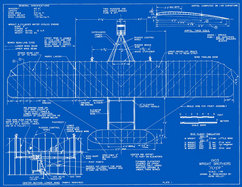
Measured drawings of the 1903 Wright Flyer, Plate 1 (top view).
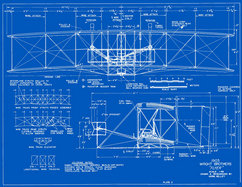
Measured drawings of the 1903 Wright Flyer, Plate 2 (front and side
views).
|
Virtual Models
|
|
|
If you aren't the hands-on sort that enjoys building physical
models, maybe you'd like a virtual model of the Wright
Flyer I for your report or project. If you poke around the web, you
can find digital Flyer models in several different languages
and formats, including VRML (Virtual Reality Mark-up Language), X3D,
3D Studio, Autodesk, and many others. To see these on screen, you
must either have the program in which the model was created or a
viewer which will read that particular format. Viewers allow you
to manipulate the model on screen, turning, panning, and zooming
into to see details, but you will not be able to append or change
the model in any way. There are a few free digital Flyer models
available, but most cost money. If you don't mind paying, visit
CGTrader –
this website offers digital models for sale from $25 to $200.
Generally, the higher the price the more detailed the model. If
historical accuracy is important, be cautious. Check out the details
against the plans we have provided in the
Scratch-Built section. If you'd rather stick to
free, you can download a modestly detailed virtual model of the
Flyer for no cost that can be manipulated in Sketchup.
This is a three-dimensional drawing program used to build
architectural and engineering models. Trimble, Sketchup's parent
company, let's you download the program and use it free for 30 days.
This allows you to add details and labels, even make artistic
renderings of the Flyer if you want to take the time to learn the
program. Or, if you'd rather not modify the file, you can simply
view and demonstrate the 3D Flyer model with a free copy of Sketchup
Viewer.
Finally, if you want free and detailed, we've built an
historically accurate digital replica of the 1903 Wright Flyer I and embedded
it in a 3D PDF file. You don't need viewers; this file can be viewed with Adobe Reader 9.0
and later. (If you don't already have a copy of Adobe Reader or want to
update your software, you can download the latest version for free by clicking
HERE.)
Once you have up-to-date Reader, simply click on the link to
3D PDF
1903 Flyer
file, wait for it to load, then open it in Adobe Reader. It
will appear with all the tools you need to
zoom, pan, slide, and turn the Flyer around. You can see it from all
sides and angles, investigate every little part. (If the Flyer
doesn't load immediately, choose "Enable all features" to see the
Flyer and the viewing controls.)
|
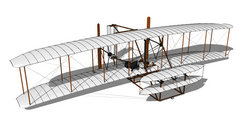
►Click
here to download a
zipped copy of the Sketchup Wright Flyer (663K).
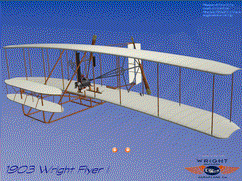
►Want to see a detailed digital model of the Flyer from any
angle?
CLICK
HERE to download the WBAC Wright Flyer I 3D PDF (about 11.8 Mb).
(Your browser must have an up-to-date
Adobe Reader plug-in to view the model.) After loading the PDF
file, choose "Enable all features" to display the Flyer and the
viewing tool bar.
|
|
|
|